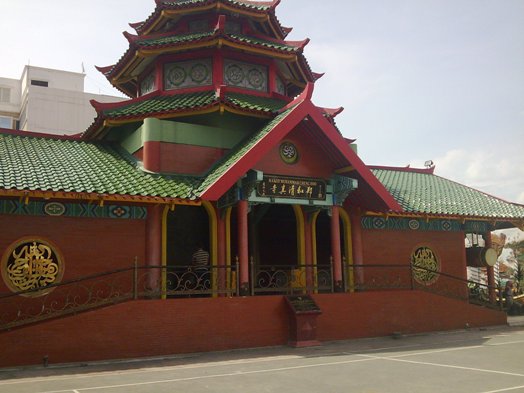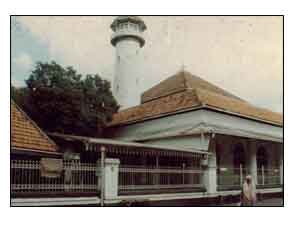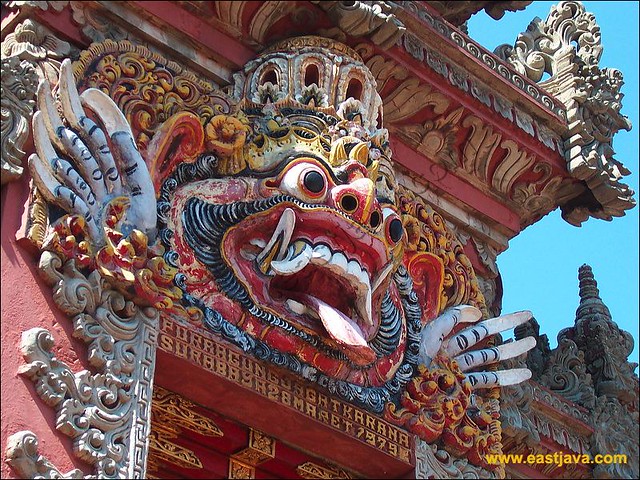Kya-Kya

Is a Chinatown in the 1900s. Development Centre Kya-Kya Kembang Jepun (PK3J) has several stages. In the beginning was the design of the entrance of PK3J are made in such a way that is not much different from its original form. Then the gate creation process is done on the beach ria Kenjeran and revamping the way in PK3J. Once completed, the road improvement on 27 May 2003 followed the installation of gates and utility construction.
For the transport process from the gate to the flower japanese Kenjeran require 15 truck trailers and six cranes. Where the weight of the gate is about 4 tons, not including dragon decoration on the upper arch. Besides the installation of gates on the 27th of May 2003, the jug is 14 utility construction will also be plugged. Construction of this utility is a backup facilities for electric, water utilities, and speakers
Meanwhile, the manager kya kya has several programs including:
Jalan Kembang Jepun * Create a comfortable area for pedestrians by freeing this path from motor vehicle traffic between 18:00 until 02:00 dawn.
* Turn the atmosphere Jalan Kembang Jepun with glittering lights and brightly lit, so the atmosphere of this street into a warm, fun and reflects a sense of security.
* Providing safe and comfortable atmosphere with the presence of security officers who portray the nuances of the prime. Instantly people into this area, ranging from parking, long road along the Kembang Jepun and when leaving the area to feel happy and safe. Closing the region against possible disturbances, such as the presence of small comfort singers, beggars, scavengers, asongan.Pengamen seller will be given its own place with the provision of better infrastructure, as well as traditional hawkers seller could take advantage of other land in the vicinity of Jalan Kembang Jepun.
* Bring an atmosphere of warmth recreation dinner with providing food and beverages that are not limited to food / beverage typical local area (Chinese cuisine, Middle Eastern cuisine, Cuisine of Indonesia) and even invited the typical foods of young people, including the snacks of the present ( Burger, Pizza, etc.) and traditional snack (Surabaya and regional).
Besides food and beverages, the manager also gave an opportunity for business people engaged in services (salons, karaoke, reflexology, etc.) and also those engaged in consumer needs (factory outlets), such as electronic equipment, clothing, assessories , and others.
The manager will open broad opportunities for this field, although it will apply also quotas for the overall program will have the diversity and comprehensiveness of existing fields.
* Liven up the atmosphere of the night by presenting a small entertainment stage (light-music), both modern and traditional, typical (Chinese, Arabic, Javanese) and even a contemporary (poetry readings, etc.), the populist (ndangdut, harp, etc.) or which appreciative (jazz, etc.). By not closing the possibility of holding events of spiritual refreshment (at night on religious holidays). Providing space-space for trade promotion and did not rule out an art exhibition or trade show / craft small scale.
* Displays the street-picture''''''''as an element of the interior regions, namely the support of local residents to maintain the facade (front face) the buildings the main building which has its own peculiarities which can color the region (such as houses of worship, etc.), buildings with distinctive architecture (Chinese architecture, Colonial Architecture, Modern Architecture) and ritual events and ceremonial residents who are able to take part in memarakan area (in places of worship ritual that allows visitors to enjoy this area.)
* Bringing comfort walking with adequate facilities (roads are flat, smooth, no holes etc.), net (roads swept, hosed even before the area was opened and after the closing), no smell (rubbish bins residents cleaned, before the site opened) , no flooding (adequate drainage, does not tarnish), brightly lit (lighting overall) and aesthetic (berlangitkan lights).
* Leisure area sufficient to provide a place to eat / drink, comfortable seating, public facilities (toilets, school) are scattered and insufficient. Including the provision of tents to eat / drink during the rainy season arrives.
* Friendliness of field officers from the moment guests enter (parking attendants), support (security, cleaning-service workers and so on) and manager of this authority. Constructing consciousness along with the owners of food booths and drink of hospitality (which includes cleanliness and food quality).
* Comfort and safety achievement parking would be part of the success of this program, this business is done by providing excellent lighting in all access to a safe location and atmosphere served since entering the region through access-access at the ends of the supporting road, by placing items safety and security officers there. Ample parking is provided with all conveniences including access to the achievement of the West, East, South and North locations.
* Constructing awareness of Surabaya city resident to own property and enjoy the city by visiting these facilities through a call, call, invitation through publications and mass media support both the print media (newspapers local / national), the electronic mass media (national and local television and Radio).
* Hand in hand with all relevant agencies either by official government agencies (Department of Tourism, Department of Culture, Infocom Department, Office of Small Medium Industries Association, revenue, etc.), Higher Education, Cooperation and support entrepreneurs with advertising (banners, signage ) along Jalan Kembang Jepun is synergy in the form of advertisements and street lighting and environmental aesthetics as well (such as sponsorship support for the construction of two Chinese Style Main Gate, at the ends of Jalan Kembang Jepun). Also worked with NGOs institutions in an effort to develop Arts and Culture.
* In cooperation with the smallest units of society such as with a small group of local traders, groups of potential local Arts and Culture, Karangtaruna, spontaneous groups of local security.
















